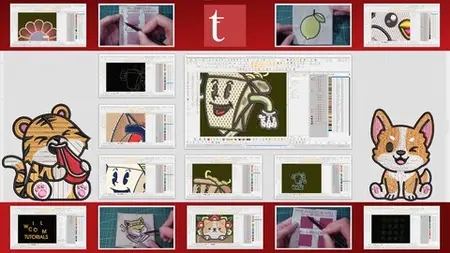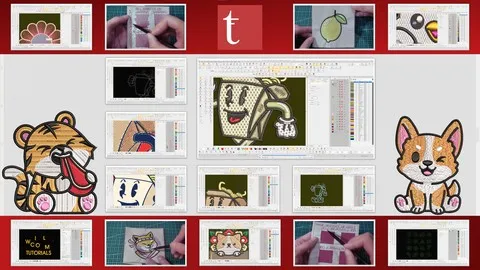Embroidery Design In Wilcom – Hands-On Solid Foundation
Published 11/2024
MP4 | Video: h264, 1920x1080 | Audio: AAC, 44.1 KHz
Language: English | Size: 13.06 GB | Duration: 10h 16m
Published 11/2024
MP4 | Video: h264, 1920x1080 | Audio: AAC, 44.1 KHz
Language: English | Size: 13.06 GB | Duration: 10h 16m
Embroidery Design in Wilcom: Build a Solid Foundation to Create Your Own Unique Designs
What you'll learn
Masterful Design Skills: Attain advanced skills in design principles, software tools, and stitching techniques.
Creative Confidence: Gain confidence to experiment with design elements, textures, and colors to unlock creativity.
Efficiency and Optimization: Learn time-saving strategies to streamline the design process, boosting efficiency without sacrificing quality.
Professional Portfolio: Build a diverse, high-quality embroidery portfolio to showcase your skills to clients or employers.
Requirements
No prior embroidery or graphic design skills are needed
Participants will only need a computer with Wilcom EmbroideryStudio installed.
Description
"Embroidery Design in Wilcom – Hands-On Solid Foundation" is the ultimate beginner-friendly course designed for anyone eager to dive into the art of embroidery design. This course is ideal whether you’re a complete beginner or have some design experience but want a stronger grasp of the essentials. With hands-on lessons and clear guidance, this course will help you navigate Wilcom EmbroideryStudio and transform your creative ideas into tangible designs.We begin with the essentials, introducing you to the interface, basic navigation, and personalized settings in Wilcom. You’ll quickly become comfortable with the software, mastering everything from lines, fills, and angles to working with connectors and perfecting start and end points. As we progress, you’ll apply these fundamentals in structured practice sessions that guide you in crafting intricate designs. Each practical exercise builds on the last, allowing you to create increasingly complex patterns while refining your precision and style.The course also covers optimization techniques that improve efficiency, helping you reduce production time without sacrificing quality. You’ll learn to streamline your workflow, an essential skill for both hobbyists and aspiring professionals.By the end of this course, you’ll have created a portfolio of high-quality, original designs that showcase your newfound skills and creativity. More importantly, you’ll have developed the confidence to bring any embroidery idea to life, whether it’s for personal projects or to kickstart a career in embroidery design. Join us and take the first step towards mastering embroidery design in Wilcom!"
Overview
Section 1: Course Introduction and Basics
Lecture 1 Introduction to the course
Lecture 2 Interface and Nagivation
Lecture 3 First Configuration and Personalized Settings
Section 2: Fundamentals of Embroidery Elements
Lecture 4 Fundamental of Line & Outline
Lecture 5 Practice 1: Creating Line & Outline
Lecture 6 Fundamental of Fill Stitches (Part 1)
Lecture 7 Fundamental of Fill Stitches (Part 2)
Lecture 8 Practice 2: Draw Fill Objects
Section 3: Connecting Design Elements
Lecture 9 Connector, Should I Run or Jump
Lecture 10 Start and End Points of an Embroidery Element
Lecture 11 ACE - Relationship between Angle, Connector & End Point
Lecture 12 Practice 3: 9 Squares
Section 4: Getting Started with Basic Embroidery Designs (Practice 4)
Lecture 13 Practice 4. Stage 1. Draw Fill Objects
Lecture 14 Practice 4. Stage 2. Draw Outlines
Lecture 15 Practice 4. Stage 3. Adjust & Connect Fill Objects
Lecture 16 Practice 4. Stage 4. Connect Outlines & Complete the Design
Section 5: Getting Started with Basic Embroidery Designs (Practice 5)
Lecture 17 Practice 5. Stage 1. Draw Fill Objects
Lecture 18 Practice 5. Stage 2. Draw Outlines
Lecture 19 Practice 5. Stage 3. Adjust & Connect Fill Objects
Lecture 20 Practice 5. Stage 4. Connect Outlines & Complete the Design
Lecture 21 Further Explanation, Improvement & Design Optimization
Section 6: Building Foundations with Simple Design Elements (Practice 6)
Lecture 22 Practice 6. Stage 1. Draw Fill Objects
Lecture 23 Practice 6. Stage 2. Draw Outlines
Lecture 24 Practice 6. Stage 3. Adjust & Connect Fill Objects
Lecture 25 Practice 6. Stage 4. Connect Outlines & Complete the Design
Lecture 26 Customize with Lettering Tool & Accordion Effect
Section 7: Combining Elements for Intermediate Designs (Practice 7)
Lecture 27 Practice 7. Part 1. Introduction to Mirror Merge. Wrealth and Kaleidoscope
Lecture 28 Practice 7. Part 2. Introduction to Fill Effects. Florentine, Liquid & Radial
Lecture 29 Practice 7. Part 3. Backtrack, Repeat & Multiple Fill Effects
Section 8: Combining Elements for Intermediate Designs (Practice 8)
Lecture 30 Practice 8. Stage 1. Draw Fill Objects
Lecture 31 Practice 8. Stage 2. Draw Outlines
Lecture 32 Practice 8. Stage 2.5. Use Star Tool for Decorate Objects
Lecture 33 Practice 8. Stage 3. Connect Fill Objects
Lecture 34 Practice 8. Stage 4. Connect Outlines & Complete the Design
Section 9: Combining Elements for Intermediate Designs (Practice 9)
Lecture 35 Practice 9. Stage 1. Draw Fill Objects (Part 1)
Lecture 36 Practice 9. Stage 1. Draw Fill Objects (Part 2)
Lecture 37 Practice 9. Stage 2. Draw Outlines
Lecture 38 Practice 9. Stage 3. Connect Fill Objects (Part 1)
Lecture 39 Practice 9. Stage 3. Connect Fill Objects (Part 2)
Lecture 40 Practice 9. Stage 4. Connect Outlines & Complete the Design
Section 10: Combining Elements for Intermediate Designs (Practice 10)
Lecture 41 Practice 10. Stage 1. Draw Fill Objects
Lecture 42 Practice 10. Stage 2. Draw Outlines
Lecture 43 Practice 10. Stage 2.5 Create Lettering
Lecture 44 Practice 10. Stage 3. Adjust & Connect Fill Objects
Lecture 45 Practice 10. Stage 4. Adjust & Connect Outlines
Lecture 46 Practice 10. Stage 4.5 Adjust Lettering & Finish the Design
Section 11: Creating Professional-Quality Designs (Advanced Technique)(Practice 11)
Lecture 47 Practice 11. Stage 1. Draw Guidelines and Outlines
Lecture 48 Practice 11. Stage 2. Draw Fill Objects based on Guidelines (Part 1)
Lecture 49 Practice 11. Stage 2. Draw Fill Objects based on Guidelines (Part 2)
Lecture 50 Practice 11. Stage 3. Adjust & Connect Fill Objects
Lecture 51 Practice 11. Stage 4. Connect Outlines & Complete the Design (Part 1)
Lecture 52 Practice 11. Stage 4. Connect Outlines & Complete the Design (Part 2)
Lecture 53 Practice 11. Stage 4. Connect Outlines & Complete the Design (Part 3)
Lecture 54 Practice 11. Stage 4. Connect Outlines & Complete the Design (Part 4)
Lecture 55 Further Explanation, Improvement & Design Optimization
This course is perfect for absolute beginners looking to start from scratch, as well as advanced users seeking to refine and expand their skills.



